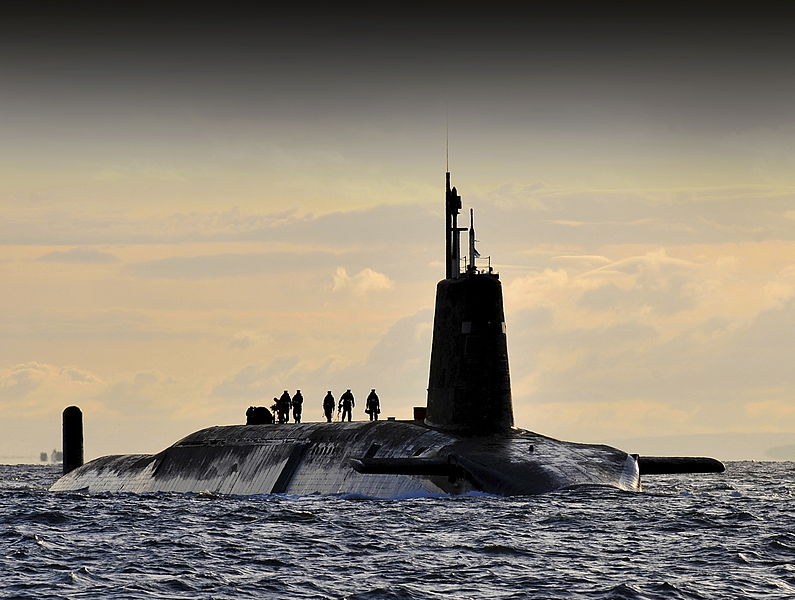Why is the United Kingdom raising its nuclear stockpile limits?
By Matthew Harries | April 2, 2021
 Nuclear submarine HMS Vanguard. Photo: CPOA(Phot) Tam McDonald/MOD accessed via Wikimedia Commons. Open Government License.
Nuclear submarine HMS Vanguard. Photo: CPOA(Phot) Tam McDonald/MOD accessed via Wikimedia Commons. Open Government License.
On March 16, the United Kingdom announced it was significantly raising a self-imposed cap on its overall nuclear stockpile, from a previous target of 180 warheads by the mid-2020s to a new cap of 260. The decision was outlined in the United Kingdom’s Integrated Review, a landmark strategic update, which also said the country will no longer declare the size of its operational warhead stockpile (previously 120), or the numbers of warheads and operational missiles deployed on submarines (previously 40 and no more than 8, respectively). A previous review in 2015 had left open the possibility of a future change in nuclear posture, although the vaguely phrased caveat was not much noticed at the time.
In essence, the United Kingdom is now reserving the right to deploy configurations of warheads on its ballistic-missile submarines that add up to significantly more nuclear explosive power than the previous limits allowed. An initial blanching of faces—and dismay about the reversal of two decades of progress towards a smaller and more transparent UK arsenal—has given way to the obvious question: Why?
Strategic analysts have been closely examining the text of the Integrated Review for clues to a changed deterrence policy and have seized on remarks by the UK defense secretary referring to improved Russian missile defenses. This explanation, if true, would be consistent with the traditional driver of UK nuclear requirements: the so-called Moscow Criterion, under which the United Kingdom believes it must have the ability to hold the Russian capital—a defended target—at serious risk. Additional strategic factors, including a broader range of targets, and the potential need to respond to limited nuclear use, have also been floated.
Other analysts have insisted that the new cap is designed to permit a bulge in the warhead stockpile for practical, rather than strategic, reasons, and that the accompanying change in doctrine is only window dressing. More skeptical observers suspect the United Kingdom’s real motivation is political, to make a general statement of post-Brexit toughness towards the world at large, send a message of nuclear buy-in towards the United States, or simply put the opposition Labour Party on the spot.
A definitive judgment is hard to reach. It is plausible that several of these factors were at play simultaneously. Nuclear decision-making is often complicated and rarely a matter of pure strategy. That said, changing the United Kingdom’s nuclear policy for primarily programmatic or political reasons, without urgent strategic justification, would be a serious misstep. So, too, would be a strengthening of the salience of UK nuclear weapons without a thorough examination of how they fit into the country’s security strategy and broader national ambitions.
Parliament should press the UK government to explain its nuclear policy changes more clearly, so there can be a properly informed debate on their merits, balanced against their costs—and so some of the more troubling explanations can be ruled out.
Chevaline redux? After a week of speculation following the Integrated Review’s release, Defence Secretary Ben Wallace appeared on a prominent Sunday talk show and, when pressed, implied that improvements in Russian missile defenses mean the British arsenal must grow in order to remain credible. He repeated the reference in Parliament at the launch of another, defense-specific white paper. There are at least two ways of interpreting these remarks.
The more dramatic reading of Wallace’s comments would be that the United Kingdom is at something resembling a second “Chevaline” moment. This would signify that an imminent or anticipated boost in Russian missile defenses will make UK nuclear warheads, delivered by Trident II D-5 submarine-launched ballistic missiles, significantly less likely to get through to their targets. Such a dynamic, at least in basic terms, led the United Kingdom to develop the Chevaline front-end system in the 1970s, in response to the belief that the Polaris missile system’s ability to reach Moscow was being degraded. Chevaline emerged from a long project to upgrade Polaris, and comprised so-called “penetration aids,” including dummy warheads and chaff to confuse missile defenses, plus better protection for the genuine warheads. The United Kingdom replaced Polaris in the 1990s with the Trident II D-5, which has multiple independently targetable warheads. The United Kingdom does not comment publicly about its countermeasures to missile defenses, but the UK’s penetration-aid expertise presumably still stands.
If the missile defense-dependent explanation is true, Wallace—unlike his ministerial forbears, who kept the Chevaline project out of the public eye for more than a decade—must have decided that the more ambiguous phrasing of the Integrated Review needed to be clarified with reference to a specific threat. In this scenario, the hypothetical response would appear to rest on sheer weight of warhead numbers boosting the probability that enough would get through, rather than (as far as we know) on a new or additional Chevaline-like penetration solution. That said, Wallace’s interestingly worded comment on TV that “a quite clear study of effectively how warheads work and how they re-enter the atmosphere means that you have to make sure they’re not vulnerable to ballistic missile defense” might be read not just as a rationale for more warheads, but as a clue to the United Kingdom’s motivations in procuring a replacement class nuclear warhead and re-entry vehicle, in parallel with the proposed US W93/Mk7 program, to replace the current version.
An authoritative assessment of future Russian missile defenses and their capability vis-à-vis UK Trident probably cannot be made using only open sources. The area defenses surrounding Moscow, including the nuclear-capable endoatmospheric Gazelle and exoatmospheric Gorgon interceptors (the latter now retired), have been crucial in setting requirements for UK nuclear capabilities in the past. In recent years, Russia has been upgrading those systems and investing in others. The US Defense Department has assessed that Russia’s forthcoming A-235 (successor to the current A-135 Moscow defenses) and S-500 systems will have “future potential” against submarine-launched ballistic missiles.
There will always be deep skepticism that any defensive system, Russian or otherwise, could be capable of thwarting a full-scale intercontinental-range ballistic-missile attack. But it would be a brave analyst who, without access to the government’s internal deliberations at the very highest level, declared with full confidence now that Russian missile defenses are not at least one trigger for the United Kingdom’s new policy. Notably, conservative former officials from the United States, including Franklin Miller and Marshall Billingslea, have in recent days lent credence to this explanation.
Running the numbers. Yet, even sticking to purely military rationales, a different interpretation of Wallace’s answer on stockpile numbers could be that Russian missile defenses are one part of a changing calculus, but not the sole ingredient.
The Integrated Review—and, upon close listening, the rest of Wallace’s televised comments—hinted at several other things going on. The United Kingdom might be thinking about the practicalities of deterring not just Russia but also China, North Korea, and possibly Iran, all at the same time—“the full range of state nuclear threats from any direction,” as the review puts it. Wallace, for his part, talked about what “the Russians and others” have been up to. China is working on its own ballistic missile defenses, and the US Defense Department has also claimed “future potential” vis-à-vis submarine-launched ballistic missiles for China’s HQ-19 system and its future midcourse interceptor.
The Integrated Review also cites “doctrinal threats” in the same sentence as announcing the warhead cap increase, which could imply a reaction to the prospect of Russia threatening limited nuclear use, with the United Kingdom boosting its ability to respond in kind. More broadly, it could also reflect a concern that the United Kingdom’s adversaries envisage a broader range of scenarios for nuclear use or coercion than it does itself—but following others down that path would be a concerning move. UK official language also makes repeated reference to Russia’s new offensive weapons, rather than only defensive systems. And in the longer term, the United Kingdom might also be worried about nuclear submarines becoming more vulnerable, which could at least theoretically explain the review’s reference to enemies seeking a “first-strike advantage.”
The relationship of all these factors to warhead numbers and their deployment is not linear, and it should not simply be assumed that more warheads deter more. But they could all create pressure for a larger arsenal.
In basic theoretical terms, aiming more warheads at a defended target could be one way of increasing the probability of sufficient numbers getting through. Another way that does not necessarily require more nuclear warheads—and one where, via Chevaline, the UK has experience—could be to introduce more complicated countermeasures.
Deploying more weapons on a single submarine, something permitted by the United Kingdom’s removal of loading limits, might allow more targets to be held credibly at risk, especially if some of those targets became better defended. A bigger stockpile overall might give the United Kingdom a better chance of having two boats at sea capable of a retaliatory strike, rather than one.
Additional warheads, whether on one deployed submarine or two, might provide more confidence that a first, limited, exchange could be conducted while holding back enough for subsequent large-scale use. In this scenario, the United Kingdom could use nuclear weapons in limited numbers, potentially using low-yield variants, while keeping more warheads in reserve for a strategic exchange. If this were to be part of the explanation, it would parallel the 2018 US Nuclear Posture Review, which provided for the introduction of a US low-yield Trident warhead variant, the W76-2, a capability the United Kingdom already possesses but which it has de-emphasised in recent years.
Lastly, more flexibility in submarine loadings might leave an adversary less certain of how many weapons it would be getting rid of, were it to strike first.
All a ruse? Plug some or all of these ingredients into the calculations of military planners, and it is not difficult to see how the answer might be that the United Kingdom needs—or at least it would feel more comfortable with—a bigger nuclear arsenal. And yet there is also a school of thought, among political types and wonks alike, that all this close reading gives the government too much credit. In this view, analysts are failing to see the political forest for the strategic trees—starting with the fact that an increased cap does not necessarily mean the United Kingdom will actually build more warheads.
The nuclear increase on paper does not need to be followed through on in practice, wrote New Statesman political editor Stephen Bush, because it was designed to hook opposition leader Sir Keir Starmer into talking about the Labour Party’s weak spot (nuclear weapons) rather than the government’s (cuts to foreign aid). ITV News political editor Robert Peston is similarly skeptical that new warheads will be built, and quotes former UK government ministers who think it is all about looking either unpredictable in the eyes of enemies or, more broadly, seized with post-Brexit dynamism. An even livelier rumor, mentioned in Parliament by Defence Committee Chair Tobias Ellwood, has also been circulating to the effect that the United Kingdom raised its cap for reasons to do with its “purchase” of new warheads from the United States.
A subset of military experts, meanwhile, think we are all being taken for a ride: The nuclear establishment actually needs a cap for more prosaic reasons, such as a temporary bulge when the next-generation warheads come in and old ones wait to be dismantled. (The UK government says those warheads will have a “very close connection, in design terms and in production terms” to the new US W93 warhead, but will not simply be bought off the shelf). By wrapping this up in strategic language the government is putting on a “rope trick,” according to one senior former defense official, to distract from the real explanation. This idea has popped up in Parliament, too.
It is not clear why the arrival of a new warhead more than a decade from now—technically out of the timeframe of the Integrated Review—would require an immediate cap increase. And if that were the specific reason, the government could always have said so. Still, a lower warhead cap likely means less practical breathing space in the cycle of maintaining, upgrading, and deploying the existing stockpile, so it could well be the case that programmatic factors more immediate than the arrival of the replacement warhead contributed to upward pressure on the UK arsenal. A realization that the target of going down to 180 warheads by the mid-2020s would be challenging to meet for practical reasons might have contributed to putting the idea of a cap adjustment on the table from the start.
Speaking as an author of some of the detailed strategic musings about the United Kingdom’s announcement, and a colleague and mentee of others, it is uncomfortable to suspect that researchers might be being suckered into giving academic cover to political or bureaucratic theater. But these explanations are not mutually exclusive, nor do they make it pointless to analyze the strategic aspects of UK policy. In the first place, policy change often has not one cause but several. Second, memories of the specific reasons for policy change sometimes fade over time, even as the effects take on a life of their own.
Multiple causality? Put yourself in the prime minister’s shoes, and imagine someone—for whatever reason—suggests the option of increasing the warhead cap. Well, you ask: what are the pros? The Ministry of Defence might say an increase will give us more firepower and flexibility to deal with a range of nasty events that might happen in the next decade or so, facing more enemies who are upgrading their capabilities. You might be told, too, that the Atomic Weapons Establishment says it will make their life easier.
Even if we don’t actually build the things, you might be advised, raising the cap will make the United Kingdom look tough in the eyes of the Russians, for once, rather than boasting about tiny reductions in the nuclear arsenal and occasionally holding votes about whether to get rid of it. More nukes might even help show the Americans that the United Kingdom is serious. Your political advisers might note (perhaps not in the same breath, for propriety’s sake) that it is a perfect trap for Labour, always divided on Trident and still branded with former leader Jeremy Corbyn’s support for unilateral disarmament.
Ok, you ask, what are the cons? The Foreign Office says it will annoy disarmament enthusiasts and non-nuclear-weapon state parties to the Non-Proliferation Treaty. Ho hum. The Ministry of Defence might admit that it might add to what is rapidly becoming a rather worrying global arms race—but that the United Kingdom didn’t start the race, after all, and alone can’t stop it. Previous governments cared about making those disarmament announcements, but what difference did it make to UK nuclear rivals? Right, you say: Let’s do it.
This is only a hypothetical sketch, and given how closely held previous British nuclear decisions have been kept, the full nature of the deliberations is unlikely to be made public for at least 30 years, if ever. But the sketch is designed to show why searching for a single cause might—assuming this is not, in fact, Chevaline round two—miss the point.
Lasting effects. However tedious it might sound to some, rolling back two decades of disarmament policy could cause additional damage to the nonproliferation regime, to the UK’s multilateral credentials, and to the long-term prospects of nuclear disarmament.
This new policy is not just a messaging problem among the usual suspects who would be critical whatever the government did. It is an embarrassment for UK diplomatic allies that have been doing their best to persuade more radically inclined non-nuclear states to keep the faith in incremental reductions, and to states such as Norway which have worked with the United Kingdom in researching verification approaches to future arms control. It fits poorly with the Biden administration’s emphasis on nuclear diplomacy, and although the change must have been briefed in Washington without drawing fatal opposition, it might be disruptive to US plans for a productive (or at least non-destructive) Nuclear Non-Proliferation Treaty (NPT) review conference, tentatively scheduled for August of this year.
The supporters of the policy change will point out that the United Kingdom’s new cap leaves it below France as the smallest of the NPT’s recognized nuclear powers. Still, if the deterrence boost is not actually as big as the government suggests, the diplomatic costs could outweigh the benefits. And those costs were largely incurred the moment the United Kingdom announced the revised cap, regardless of whether the extra warheads ever get built.
Supporters might also argue that this is an opening bid for future arms control talks which leaves the United Kingdom a more realistic negotiating buffer. But that case has not yet been made by the British government, which provides in the Integrated Review little more than platitudes about its commitment to arms control and disarmament, and no concrete vision for future negotiations.
Perhaps more importantly, these kinds of policy shifts—whatever the original cause—tend to take on a life of their own. Just look at the United Kingdom’s nuclear history. The country ended up with ballistic missiles on nuclear submarines in the 1960s not because the Ministry of Defence took a blank sheet of paper and decided that was what it wanted, but because the air-launched missile it had expected to buy from the Americans, Skybolt, got cancelled, and then-Prime Minister Harold Macmillan persuaded then-President John F. Kennedy to sell the United Kingdom the submarine-launched Polaris instead. From then on, Britain’s nuclear doctrine was influenced by the capabilities it had and could afford—a perfectly respectable doctrine in intellectual terms, but not necessarily one generated from first principles.
The political and practical reasons for the Integrated Review’s decision may well be forgotten in ten or twenty years, and the United Kingdom will be left with a policy that says that it reserves the right to build a bigger arsenal because it is needed to deter a broader and more demanding range of threats. Whether or not the decision had a single strategic rationale, it could have long-lasting strategic effects.
Where does the United Kingdom go from here? A good first step would be for Parliament to push the government to rule out—if it can—the damaging suspicion that all this is a programmatic blip dressed up in strategic clothing. As discussed above, there are reasons to doubt the theory. But if it were true, it would be a damning indictment of successive UK governments’ management of the nuclear enterprise. Indeed, the United Kingdom’s defense-nuclear infrastructure is under obvious strain, with a new warhead assembly-and-disassembly facility badly delayed and over budget, and a project to build a new enriched-uranium handling facility suspended after initial plans went awry. If factors such as these contributed to the cap increase, blaming the worsening security environment would be irresponsible, causing needless diplomatic damage.
More broadly, Parliament should examine the decision-making process that led to this outcome. If it is often the job of nuclear planners to explore worst-case scenarios and lobby for increased capability, then it is the job of political leaders and other officials to place them in a broader context. Where did the proposal for an increased stockpile cap come from? Where did the proposal for reduced operational transparency come from? Which elements of the United Kingdom’s military leadership were consulted, and what did they say? What kind of consultations were held with allies, including the United States? How did nuclear policy decision-making interact with the process of drafting the Integrated Review?
Lastly, Parliament should test the assumptions that underpin the new policy. Which “doctrinal threats” are of most concern to the United Kingdom, and why do they require a change in its available nuclear destructive power? Does the United Kingdom, which used to refer explicitly to a sub-strategic role for Trident, believe in limited nuclear retaliation as a kind of warning shot? If so, why would this not invite further escalation? Are there other sub-strategic purposes for UK nuclear forces? Is a strengthened nuclear arsenal intended to compensate for cuts to the UK’s large-mass conventional military forces?
There are good cross-party reasons for a closer Parliamentary look at the nuclear establishment, from the deterrent’s supporters and detractors alike. In the past year, we have learned that the United Kingdom is building a replacement warhead; that the replacement program is strongly dependent on the United States; and that the Atomic Weapons Establishment will be renationalized to deal with chronic problems. Meanwhile, the government is making the case that nuclear weapons are newly relevant to international security and is reversing 20 years of British declaratory policy to focus much more clearly on deterrence, rather than disarmament.
Against this background, it is not good enough to greet the Integrated Review’s nuclear bombshell with a smirk and a confident assertion about the “real” reason for the change. It is time to ask difficult questions, starting but not ending with the most basic one: why?
Together, we make the world safer.
The Bulletin elevates expert voices above the noise. But as an independent nonprofit organization, our operations depend on the support of readers like you. Help us continue to deliver quality journalism that holds leaders accountable. Your support of our work at any level is important. In return, we promise our coverage will be understandable, influential, vigilant, solution-oriented, and fair-minded. Together we can make a difference.
















As I read somewhere, the British Empire ended but British imperialism didn’t.
Very impressive analysis. I tend to the pessimistic “everything is political” view myself, and have trouble seeing the UK as a serious country today. They seem just an exhausted and spent force (and, frankly, the US doesn’t seem too far behind). To whatever extent the UK has the wherewithal to produce new weapons, the effort is likely limited to refreshment of obsolete weapons and training of new talent. And any serious engineering improvements will likely be in the hands of the Chinese before any new weapons are ever deployed. From an arms control perspective, this sets an awfully bad tone… Read more »
The 1947 Truman Doctrine is getting a bit long in the tooth. Maybe Russia is not the enemy? Maybe the majority of Russians and Americans and Europeans want peace, and its only a small minority of hard liners who want the arms race? Should the whole World be held hostage to this small minority? .